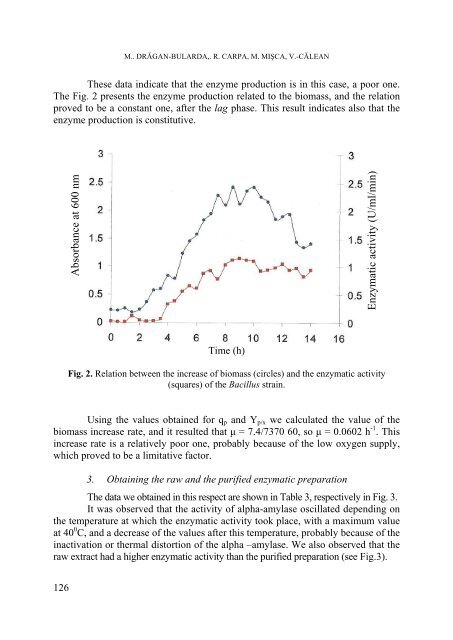biologia - Studia
biologia - Studia
biologia - Studia
Create successful ePaper yourself
Turn your PDF publications into a flip-book with our unique Google optimized e-Paper software.
M.. DRĂGAN-BULARDA,. R. CARPA, M. MIŞCA, V.-CĂLEAN<br />
These data indicate that the enzyme production is in this case, a poor one.<br />
The Fig. 2 presents the enzyme production related to the biomass, and the relation<br />
proved to be a constant one, after the lag phase. This result indicates also that the<br />
enzyme production is constitutive.<br />
Absorbance at 600 nm<br />
Enzymatic activity (U/ml/min)<br />
Time (h)<br />
Fig. 2. Relation between the increase of biomass (circles) and the enzymatic activity<br />
(squares) of the Bacillus strain.<br />
Using the values obtained for q p and Y p/x we calculated the value of the<br />
biomass increase rate, and it resulted that µ = 7.4/7370 60, so µ = 0.0602 h -1 . This<br />
increase rate is a relatively poor one, probably because of the low oxygen supply,<br />
which proved to be a limitative factor.<br />
3. Obtaining the raw and the purified enzymatic preparation<br />
The data we obtained in this respect are shown in Table 3, respectively in Fig. 3.<br />
It was observed that the activity of alpha-amylase oscillated depending on<br />
the temperature at which the enzymatic activity took place, with a maximum value<br />
at 40 0 C, and a decrease of the values after this temperature, probably because of the<br />
inactivation or thermal distortion of the alpha –amylase. We also observed that the<br />
raw extract had a higher enzymatic activity than the purified preparation (see Fig.3).<br />
126
















